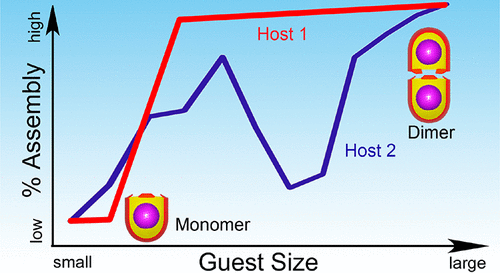当前位置:
X-MOL 学术
›
J. Phys. Chem. B
›
论文详情
Our official English website, www.x-mol.net, welcomes your feedback! (Note: you will need to create a separate account there.)
Guest Controlled Nonmonotonic Deep Cavity Cavitand Assembly State Switching
The Journal of Physical Chemistry B ( IF 3.3 ) Pub Date : 2017-11-16 00:00:00 , DOI: 10.1021/acs.jpcb.7b09021 Du Tang 1 , J. Wesley Barnett 1 , Bruce C. Gibb 2 , Henry S. Ashbaugh 1
The Journal of Physical Chemistry B ( IF 3.3 ) Pub Date : 2017-11-16 00:00:00 , DOI: 10.1021/acs.jpcb.7b09021 Du Tang 1 , J. Wesley Barnett 1 , Bruce C. Gibb 2 , Henry S. Ashbaugh 1
Affiliation

|
Octa-acid (OA) and tetra-endo-methyl octa-acid (TEMOA) are water-soluble, deep-cavity cavitands with nanometer-sized nonpolar pockets that readily bind complementary guests, such as n-alkanes. Experimentally, OA exhibits a progression of 1:1 to 2:2 to 2:1 host/guest complexes (X:Y where X is the number of hosts and Y is the number of guests) with increasing alkane chain length from methane to tetradecane. Differing from OA only by the addition of four methyl groups ringing the portal of the pocket, TEMOA exhibits a nonmonotonic progression of assembly states from 1:1 to 2:2 to 1:1 to 2:1 with increasing guest length. Here we present a systematic molecular simulation study to parse the molecular and thermodynamic determinants that distinguish the succession of assembly stoichiometries observed for these similar hosts. Potentials of mean force between hosts and guests, determined via umbrella sampling, are used to characterize association free energies. These free energies are subsequently used in a reaction network model to predict the equilibrium distributions of assemblies. Our models accurately reproduce the experimentally observed trends, showing that TEMOA’s endo-methyl units constrict the opening of the binding pocket, limiting the conformations available to bound guests and disrupting the balance between monomeric complexes and dimeric capsules. The success of our simulations demonstrate their utility at interpreting the impact of even simple chemical modifications on supramolecular assembly and highlight their potential to aid bottom-up design.
中文翻译:

访客控制的非单调深腔Cavitand装配状态切换
辛酸(OA)和四内甲基辛酸(TEMOA)是水溶性的深腔空洞,具有纳米级非极性口袋,可轻松结合互补的客体,例如正构烷烃。实验上,OA表现出1:1至2:2至2:1的宿主/客体复合体(X:Y,其中X是宿主的数量,而Y是宾客的数量),并且烷烃链的长度从甲烷增加到十四烷。与OA不同的是,TEMOA的组装态从1:1到2:2到1:1到2:1随宾客长度的增加而呈非单调性发展,而与OA的区别仅在于它在口袋的入口处有四个甲基。在这里,我们提出了一个系统的分子模拟研究,以解析分子和热力学决定因素,这些决定因素区分了对这些相似宿主观察到的组装化学计量的连续性。通过伞式采样确定的主机和宾客之间的平均力势可用来表征缔合自由能。这些自由能随后用于反应网络模型中,以预测组件的平衡分布。我们的模型准确地再现了实验观察到的趋势,内甲基单元限制了结合口袋的开放,限制了可用于结合的客人的构象,并破坏了单体复合物和二聚体胶囊之间的平衡。我们仿真的成功证明了它们在解释甚至简单的化学修饰对超分子组装的影响方面的效用,并突出了它们有助于自下而上设计的潜力。
更新日期:2017-11-16
中文翻译:

访客控制的非单调深腔Cavitand装配状态切换
辛酸(OA)和四内甲基辛酸(TEMOA)是水溶性的深腔空洞,具有纳米级非极性口袋,可轻松结合互补的客体,例如正构烷烃。实验上,OA表现出1:1至2:2至2:1的宿主/客体复合体(X:Y,其中X是宿主的数量,而Y是宾客的数量),并且烷烃链的长度从甲烷增加到十四烷。与OA不同的是,TEMOA的组装态从1:1到2:2到1:1到2:1随宾客长度的增加而呈非单调性发展,而与OA的区别仅在于它在口袋的入口处有四个甲基。在这里,我们提出了一个系统的分子模拟研究,以解析分子和热力学决定因素,这些决定因素区分了对这些相似宿主观察到的组装化学计量的连续性。通过伞式采样确定的主机和宾客之间的平均力势可用来表征缔合自由能。这些自由能随后用于反应网络模型中,以预测组件的平衡分布。我们的模型准确地再现了实验观察到的趋势,内甲基单元限制了结合口袋的开放,限制了可用于结合的客人的构象,并破坏了单体复合物和二聚体胶囊之间的平衡。我们仿真的成功证明了它们在解释甚至简单的化学修饰对超分子组装的影响方面的效用,并突出了它们有助于自下而上设计的潜力。



























 京公网安备 11010802027423号
京公网安备 11010802027423号